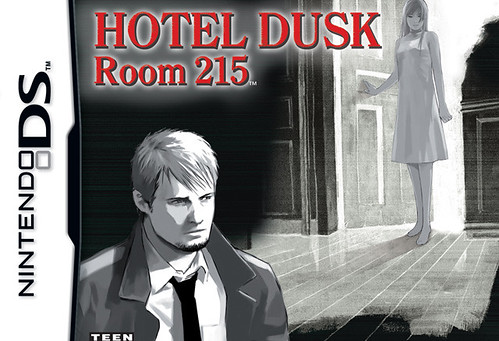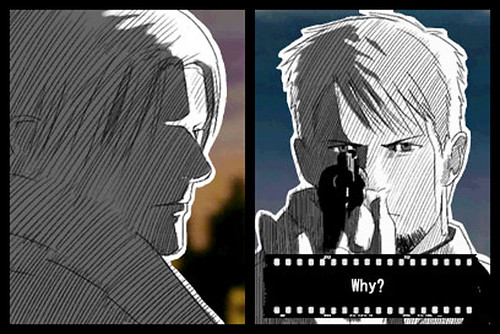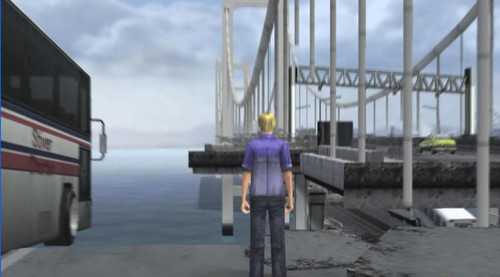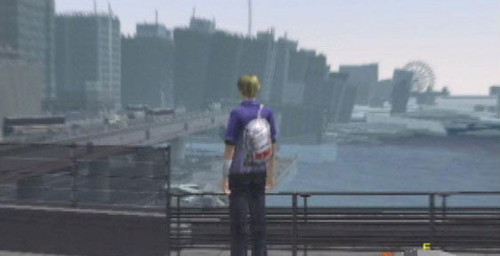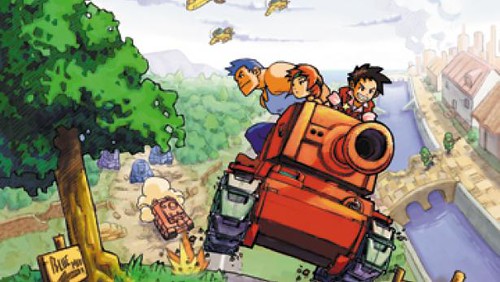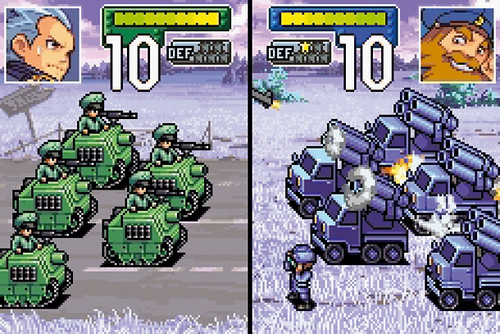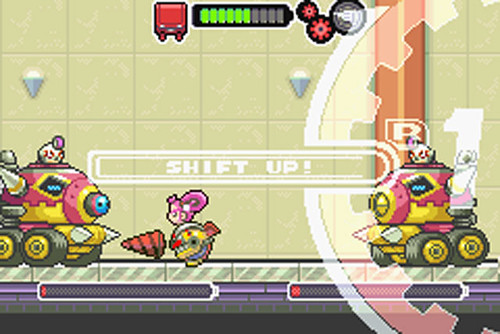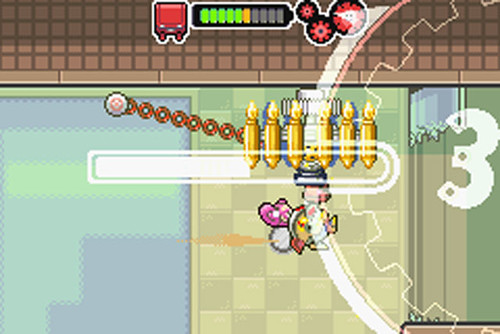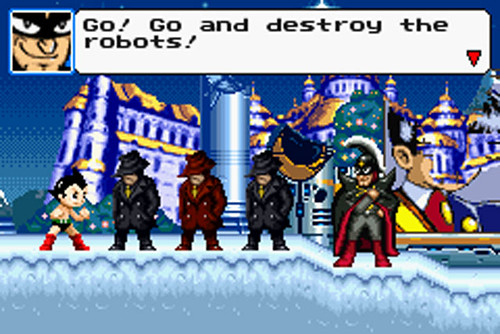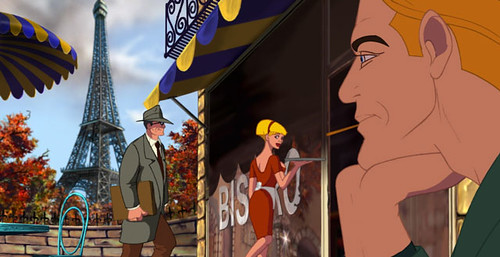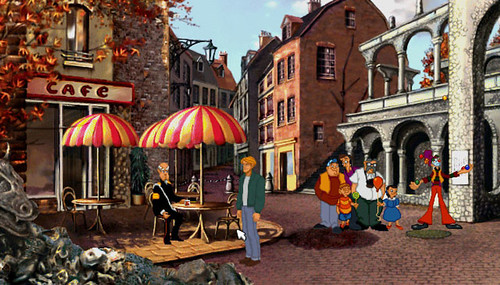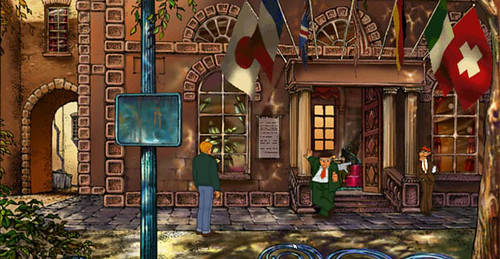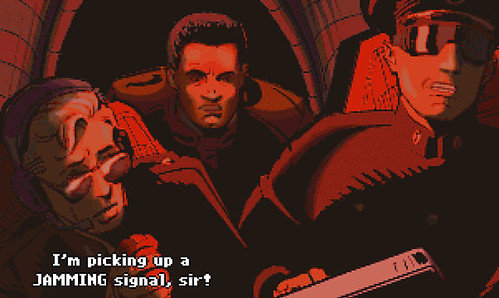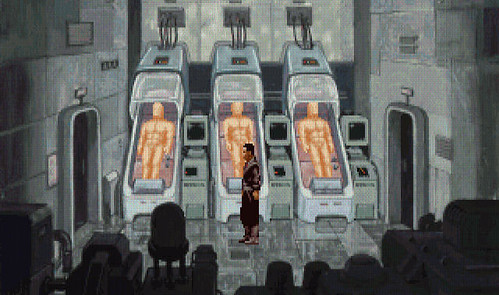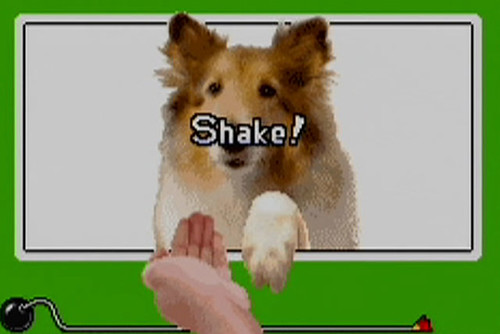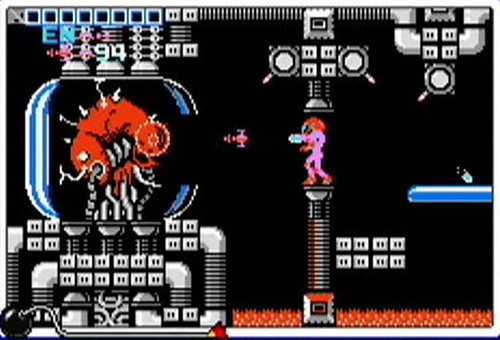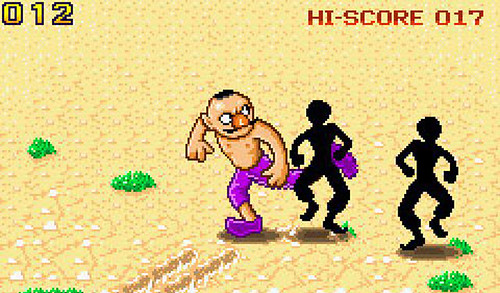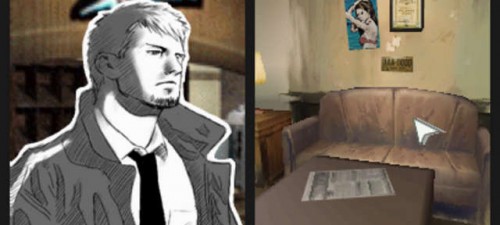
[1001] Hotel Dusk: Room 215
I’ve been embracing the world of handhelds, and am now in possession of a 3DS. Rather than play the latest and greatest 3D titles though, I’ve gone back through the 1001 and dug out a few weird sounding ones for the original DS (thank you backwards compatibility).
And this one certainly is a bit weird. It’s called:
1001 No.61: ‘Hotel Dusk: Room 215′ (DS, 2007)
It’s essentially a little mystery game. You’re some ex-cop, who works for a kind of private detective agency that poses as a door-to-door sales company. You apparently left the force because you shot your partner (Bradley) but are convinced he’s still alive and out there somewhere. And for some reason you’ve ended up in some deadbeat hotel. So far so weird.
But it gets much weirder, in that the hotel is full of coincidences and characters from your past, and the whole thing becomes one crazy mystery — with red herrings, dead ends and twists all over the place. The actual gameplay is pretty much made up of one main thing — dialogue. To play, you hold the DS vertically like a book, and it sure feels like one — conversations seem to go on forever.
Be sure to be paying attention though — as an ex-cop, of course it’s pretty much your duty to go sticking your nose in all over the place, and so you do with great delight. What this means is that every now and then there’s a kind of interrogation as each mini-mystery comes to a close, and if you ask the wrong thing or miss a vital clue — GAME OVER.
It’s got a great visual style, rotoscoping making it almost comic-book like — and has obviously Japanese roots. But it’s been localised really well, and the dialogue (although bloody lengthy) is well written and pretty engaging. I did actually end up caring about the characters, which shows they’re doing something right.
It tries admirably to use some of the DS’s unique features, like the stylus etc, but it’s obviously in the relatively early days of the DS. It’ll never win any ‘best game ever’ awards, but despite being a pretty linear narrative, with no real choices apart from the correct ones, it’s good fun — and as always with things like this it’s just nice to see something that’s a break from the norm.

[1001] Disaster Report
Hmm. A game, based in Japan, about earthquakes and tsunamis… You certainly couldn’t make something like this nowadays, and indeed they can’t — there was a planned sequel to this for PS3 that was cancelled in light of the 2011 earthquakes in Japan.
1001 No.60: ‘SOS: Final Escape / Disaster Report’ (PS2, 2003)
Now this is not a mainstream game in the slightest. On first glance it looks like your standard 3rd person PS2 classic — but what are the bad guys? Terrorists? Aliens? Zombies? The answer is none of these (kinda). It’s your environment.
You know all those disaster movies, where some massive crisis hits a city and everyone enters a struggle for survival? Ever think that’d make a good game? Well someone certainly did, and that became ‘Disaster Report’ — or as it’s known in the UK for some reason, ‘SOS: Final Escape’.
You’re just a guy coming into your first day of a new job, on a new man-made island — when suddenly an earthquake strikes and chaos ensues. You miss the first rescue chopper, and so from then on you’re left to try and find safety within a constantly collapsing city.
Whether it actually does make a good game is another question. It is quite fun for the most part, and has some interesting mechanics — you can construct things to help you on your way, such as by combining a hard-hat, torch and tape to make a headlamp; and the reliance on water is a good way to keep you moving — you have a ‘thirst’ level as well as a health meter.
There are some basic choices along the way that can dictate different endings, but that would mean that you actually care about the plot — which you won’t. As you might expect, there is some dastardly conspiracy behind the disaster you’re caught up in — but it does all get rather silly. As it was originally a Japanese game, the dialogue and voice acting has been localised for English speaking countries — but it’s pretty damn bad in places, and the controls are clunky as hell.
Like quite a few games I’ve come across so far in the 1001, this seems to be on the list mainly because it’s rather unique — and while it is pretty rough around the edges, it’s always good to see something new.
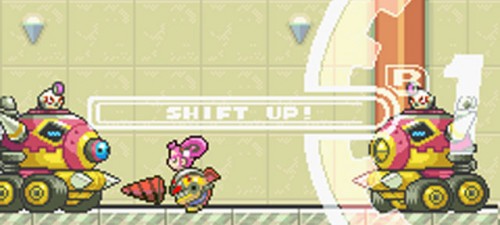
[1001] Advanced gaming…
Here’s a few games to try on the awesome little handheld that is the Gameboy Advance…
1001 No.57: ‘Advance Wars’ (Gameboy Advance, 2002)
In the past, turn-based-strategy games have turned me right off. These are type of the games where, unlike something like Command & Conquer, each player takes turns to decide their next move — and decisions are dictated by a number of points that can be used to move, attack etc.
Frankly I always found the idea extremely boring and tedious — where would the excitement be? Turns out I was wrong… so very wrong.
Advance Wars has tension — and if anything it is even more tense than your normal strategy game. What’s my next move? What is my opponent thinking? It’s like a game of chess, but the kind of chess where your pieces go around shooting, shelling and bombing eachother. It’s brilliant. And it’s tough — one small error early on can cost you the game, and it requires some real careful thought about how you deploy your armies. Don’t you dare consider sending those little mechanised infantry against those heavy tanks — and woe betide you if you leave your anti-air units undefended!
Try it, it’s brilliant fun, with awesome anime style graphics and a good learning curve. Thanks 1001 for getting me to try Advance Wars! There were a couple of sequels too, so at some point I’ll have to check them out…
1001 No.58: ‘Drill Dozer’ (Gameboy Advance, 2006)
It’s always great to see something fresh, a new spin on an old idea — and so I really enjoyed stumbling upon Drill Dozer, an odd little 2D platformer on the Gameboy Advance. It’s like very many games of its type, with varied levels, bad guys, and creative end-of-stage bosses — but what makes Drill Dozer different is in the name: your drill.
You basically control a mini drilling machine, and with the use of the L + R buttons you can shift through gears for more power. Your drill is your one and only tool — it is your weapon but also is used for all sorts of things — spin through maintenance shafts; propel yourself across gaps; attach a propeller to go through water, or fly through the air.
The original cartridge featured a built-in rumble pack; but was never released in Europe. A snappy storyline, funny dialogue, cute graphics, and not too long — this one is most definitely worth a go.
1001 No.59: ‘Astro Boy: Omega Factor’ (Gameboy Advance, 2005)
Not a huge amount to say about this one — it’s a brilliant side scroller by some of the guys who made Gunstar Heroes, so you can guess at both the tough level of difficulty and the epic madness that’s in store for you should you try it.
It’s based on some anime tv show thing, which probably adds something if you know the characters — but it doesn’t matter. One odd thing about it is the amount of revisiting of old levels you need to do to get the true ending — [spoiler alert!] the first time through the game, you actually lose. Weird. And tough. But good. Features flying robot horses.
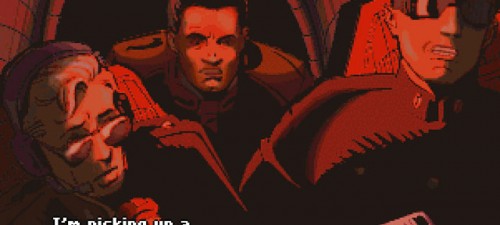
Point ‘n’ Click roundup: Revolution (+free games!)
While LucasArts are known as the kings of Point ‘n’ Click, another studio in the 90’s was producing some of the best and most gripping adventure games of all time — and they were British. Revolution Software, based in York, were behind one of the biggest franchises in adventure game history — Broken Sword. The 1001 book touches on the first game in the series, as well as another point and click classic, Beneath a Steel Sky.
1001 No.55: ‘Broken Sword’ (1996)
Playing Broken Sword is one of my fondest childhood memories, and is one of those games where seeing the opening cutscene and first screen of the game just brings back waves of nostalgia.
It’s an amazing story, an adventure that starts so simply but ends up in locations around the world. You are George Stobbart, a simple American tourist, caught up in an explosion at a Parisian Café. Everything and everyone is of course not as they seem, and the plot descends into a complex conspiracy, involving murder, deception and the Knights Templar.
It’s a brilliant plot, one that twists and turns all over the place as more mysteries are uncovered. The voice acting, sound and music are all top notch, and the controls are so refined compared to the earlier LucasArts adventures. Despite being set mostly in France and starring an American, it’s full of very British humour — and the puzzles are clever but not so abstract that it requires a walkthrough at every step.
I’m a huge fan of this whole series, which is still going today, but the original game is undoubtedly the best. Play it, and the sequel ‘The Smoking Mirror’, and if you like them try the others — they went 3D for the 3rd game onwards, so it’s a bit of an acquired taste. Never feels quite the same as the good old original…
1001 No.56: ‘Beneath a Steel Sky’ (1994)
One of the earliest adventure classics from Revolution Software, Beneath a Steel Sky is set in a dystopian future, where the world has been ravaged by conflict and pollution. There’s a great atmosphere throughout, and it’s awesome. You can see how Revolution honed their craft, going on to produce the Broken Sword series — and if you’re a sci-fi fan like me, you’ll love it.
It’s short but sweet, with some excellent humour, but also a real sense of danger — you can die in these games, not like in those cutesy LucasArts adventures! Like Broken Sword, your character is thrown into a mystery, and you have to uncover the truth about the city that you’re lost in. It was a huge commercial success at the time, and won numerous awards — and is still called by some the best adventure game of all time.
Get some free games
One of the best things about this game though is that it is now freeware — either sign up with www.gog.com (an essential resource for your classic gaming needs) and download it from them, or get it straight from www.scummvm.org — which I hope you’ve visited already to get your old awesome LucasArts games working. You can also grab Lure of the Temptress while you’re there — the first game that Revolution produced.
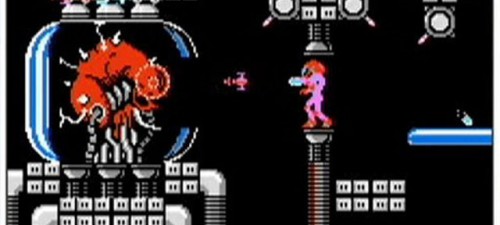
[1001] Wario Ware
It’s a little difficult to describe the WarioWare series — every game is very simple at heart, and yet so brilliantly put together. You could call them a bunch of ‘minigames’, and have done with it — but that doesn’t come close to showing how much fun and often downright hilarious these games can be. The UCHG had fun a few years back with the Wii edition of the series, ‘Smooth Moves’ — check out that vid here.
The 1001 includes a couple from the series:
1001 No.53: ‘WarioWare, Inc.: Mega MicroGames! (2003)
& No. 54: ‘WarioWare: Twisted!’ (2005)
Mega MicroGames was the first in the series, with Twisted! coming out later — both on the Gameboy Advance. All WarioWare titles feature the character Wario, straight out of the Mario series of Nintendo games — but the story and use of characters is never important. What is important are the minigames — and there are tons of them.
Reaction times are a huge factor in each game. You have mere seconds to assess what the hell is going on on-screen, and then react accordingly. The sheer randomness and bizarre nature of some of the minigames is what gives the WarioWare series its charm: some challenges range from trying to shave someone’s beard off, to catching weird bits of food to make a giant sandwich. And some of them are really odd — but the controls remain ever so simple it becomes instinctive in no time.
Each section of each game has a set of different characters, together with their own kind of theme, my favourite being ‘9 Volt and 18 Volt’. Like the UCHG these guys love retro games, and every minigame is full of references to bits of gaming history. Part of the fun is just recognising what each screen has been pulled from.
All these WarioWare games are similar at their core. The Wii version obviously uses the Wiimote, and the ‘Twisted!’ edition actually shipped with a kind of accelerometer built into the cartridge to provide the actions — though because of the mercury in the cartridge was never allowed a European release. I really urge you to track down at least one game from this series — it’s hard to explain how much fun it can be, so just give it a go yourself.

